To walk through Jerusalem’s residential neighborhoods is to sense that the stones have a story to tell, the pavements exude history, and echoes of time gone by linger in the air. Many tales here beg to be told.
Jerusalem’s vibrant neighborhood Rehavia serves as the fascinating subject of German Jerusalem by Thomas Sparr. Sparr spins the tale of the airy, garden-filled neighborhood near downtown Jerusalem, established in the 1930s by German Jewish immigrants as a center of culture, intellect, and peaceful although dynamic daily life. Spacious streets marked by verdant greenery and iconic stone apartment buildings became the homes of transplanted German Jews who enjoyed their own flavor of cafe society, where sparkling conversation about philosophy, literature, and the arts flourished. Luminaries such as philosophers Gershom Scholem and Martin Buber, architect Erich Mendelsohn, authors S.Y. Agnon and Amos Oz, political theorist Hannah Arendt, poets Yehuda Amichai and Lea Goldberg, and many others frequented Rehavia either as residents, habitues of the cozy cafes, or both.
German architect Richard Kaufmann designed Rehavia as “systematically ordered lattice streets” —even the physical layout reflects the measured beauty and structure characteristic of the residents. The Hebrew word rehavia translates to “wide spaces” and, although by today’s standards most of the streets seem narrow and congested with Jerusalem’s heavy traffic, the name still reflects the expansive cultural discourses that form a large part of Rehavia’s history. Synagogues, schools, and municipal offices added texture to the neighborhood and enhanced its vitality and energy, as did the mix of secular, traditional, and religious inhabitants.
Sparr describes the tastes and aromas characteristic of Rehavia in addition to its sights, observing that a trip through Rehavia can be a sensory experience as well as an intellectual one. Still, the overwhelming image of the Rehavia of the past, which resonates in the present, is the highly developed intellectual discourse characteristic of the German Jewish presence in the area.
This engagingly written history brings a significant neighborhood to life as it narrates the story of its residents, enticing those who may not be familiar with this part of Jerusalem to further explore its historical roots as well as its modern joys.
Michal Hoschander Malen is the editor of Jewish Book Council’s young adult and children’s book reviews. A former librarian, she has lectured on topics relating to literacy, run book clubs, and loves to read aloud to her grandchildren.





